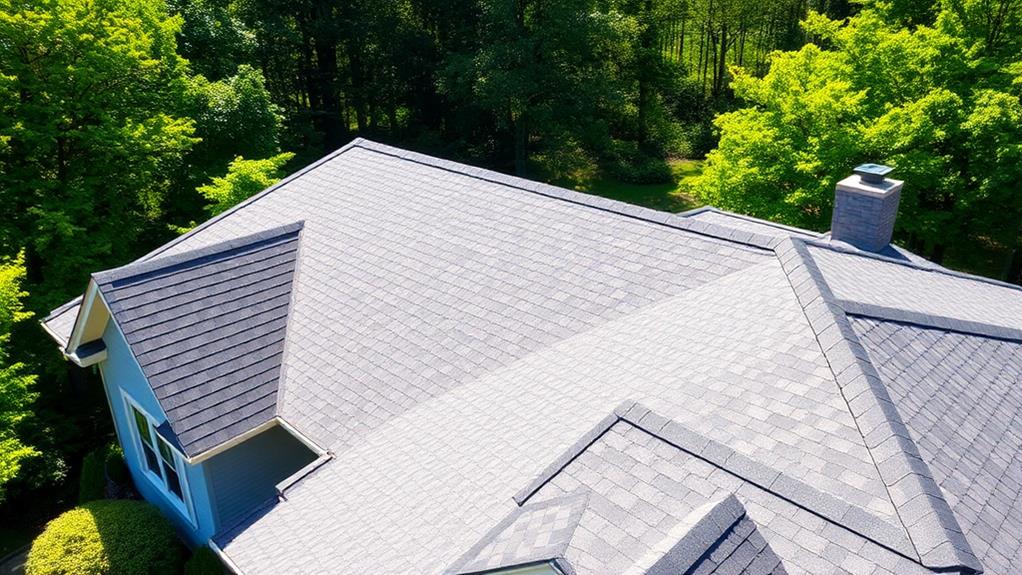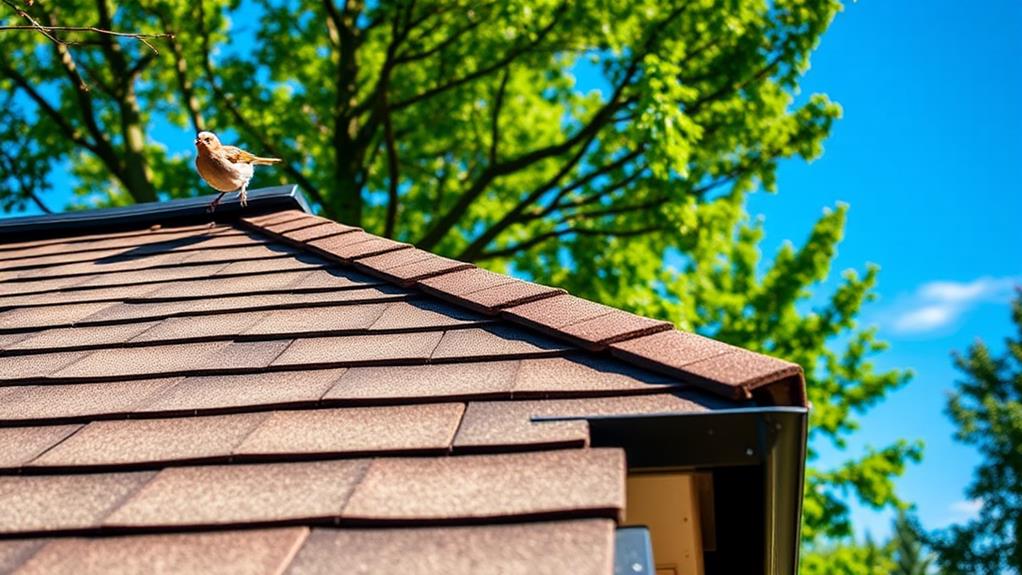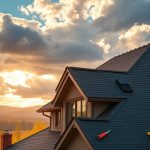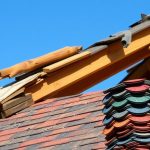Residential roof maintenance is vital for maintaining the structural integrity, safety, and energy efficiency of your home, extending its lifespan and preserving property value. By conducting regular inspections, addressing minor issues such as missing shingles, damaged flashing, or degrading underlayment, you can prevent leaks and water damage that often compromise the underlying structure. Additionally, routine maintenance guarantees adequate ventilation and drainage, improving energy efficiency by regulating indoor temperature and reducing HVAC reliance. Services may include storm damage repair, snow and ice dam removal, and gutter maintenance, all contributing to a well-maintained and resilient roof. Explore further to enhance your home's longevity and performance.
Roofing Highlights
- Regular inspections can identify and fix minor roofing issues before they become major problems.
- Routine maintenance ensures the roof remains structurally sound, enhancing safety and property value.
- Proper roof care can increase energy efficiency, reducing utility bills and environmental impact.
- Professional services include storm damage repair and preventative interventions for long-lasting roofs.
- Homeowners can benefit from expert consultations to keep their roofs in optimal condition year-round.
Roof Maintenance Importance

Roof maintenance plays a pivotal role in safeguarding the structural integrity of a home by preventing detrimental issues such as leaks and water damage, which can lead to costly repairs. Regular upkeep not only extends the lifespan of the roof but also enhances energy efficiency by ensuring proper insulation and reducing heat loss or gain.
Utilizing experienced inspectors guarantees a thorough evaluation of the roof's condition, addressing potential problems before they escalate. Additionally, timely maintenance can defray the costs of repairs and replacements while promoting a more sustainable living environment.
Prevent Structural Damage
Ensuring regular maintenance of residential roofs plays a pivotal role in preventing structural damage, safeguarding the overall integrity of a home. A roof serves as a protective shield against external elements, and any neglect can lead to severe consequences, compromising both safety and comfort. Addressing minor issues, such as missing shingles or cracked tiles, before they escalate is indispensable in avoiding costly repairs and ensuring the underlying structural components remain resilient.
Moisture infiltration is a primary concern that arises from inadequate roof maintenance. When water enters through unaddressed gaps or leaks, it can lead to wood rot, mold growth, and even compromise the structural supports of the home. This progressive destruction requires attentive inspections and timely interventions to prevent weakening of the roof's framework.
Furthermore, regular maintenance fosters a sense of community responsibility among homeowners, as well-cared-for properties contribute to neighborhood aesthetics and value. Proactive care, including cleaning and professional assessments, strengthens communal bonds, reflecting a collective commitment to preserve our living environments. Consequently, by understanding the pivotal role of roof maintenance, homeowners not only protect their investment but also actively participate in maintaining the structural harmony and integrity of their homes and neighborhoods.
Extend Roof Lifespan
Longevity is an essential benefit derived from diligent roof maintenance, considerably extending the life span of a roof. By consistently engaging in activities such as regular inspections, cleaning, and timely repairs, homeowners can exceedingly delay the need for costly replacements. A well-maintained roof not only stands resiliently against harsh weather conditions, but also protects the overall structural integrity of the home. This proactive approach fosters a sense of security and belonging, knowing one's home is enduringly safeguarded.
Regular maintenance involves identifying potential issues such as missing shingles, damaged flashing, or degrading underlayment before they escalate into more severe problems. Addressing these minor concerns promptly with professional intervention minimizes long-term damage and curtails unexpected future expenses.
Additionally, ensuring proper ventilation and drainage mechanisms are in place can prevent moisture build-up and subsequent roof decay, thereby enhancing the roof's longevity.
Moreover, routine care cultivates an aesthetically pleasing and uniformly functional exterior, enhancing both curb appeal and property value. For homeowners who seek to integrate into communities with shared standards of pride in residence, investing in roof maintenance becomes a fundamental part of sustaining harmony and uniformity within these valued spaces.
Enhance Energy Efficiency
A well-maintained roof markedly contributes to a home's energy efficiency, offering tangible benefits in both comfort and cost savings. When a roof is meticulously cared for, it secures a seamless barrier against environmental elements, preventing heat loss in the colder months and shielding against excessive heat in the summer. This regulation of indoor temperature decreases the reliance on heating and cooling systems, translating into lower energy consumption and, consequently, reduced utility bills. The synergy between proper insulation and a robust roofing system forms the backbone of a harmonious and eco-friendly living environment.
In addressing the community's desire for sustainable living, regular roof inspections, repairs, and maintenance emerge as indispensable practices. Professional attention to potential issues such as cracked tiles, missing shingles, or gaps in insulation not only preserves the roof's structural integrity but also enhances its thermal performance. By ensuring that every element of the roofing system is optimized, homeowners can experience a more stable indoor climate. Integrating such proactive measures enhances the overarching sense of belonging within a community committed to environmental stewardship. As a result, maintaining one's roof becomes an act that transcends personal benefits, contributing positively to society at large.
Benefits

Residential roof maintenance offers several key benefits, foremost among them the ability to prolong the lifespan of your roof by addressing minor issues before they escalate into significant concerns. Regular maintenance also guarantees that your roof provides reliable protection against the elements, including rain, snow, and wind, as roofs are part of the building envelope.
Prolongs Roof Lifespan
Through consistent and proactive roof maintenance practices, homeowners can markedly extend the lifespan of their roofs, thereby maximizing the return on their investment. Regular inspection and maintenance enable the early detection of minor issues, such as small leaks or displaced shingles, that could develop into more significant problems over time. By addressing these concerns promptly, durability is enhanced, and the structural integrity of the roofing system is preserved.
Moreover, routine cleaning of gutters and roof surfaces is indispensable in preventing the accumulation of debris that can trap moisture, leading to material deterioration. Moisture retention often results in the growth of mold and mildew, which can severely damage roofing components and impact the overall environment of the home. Frequent maintenance acts as a safeguard against such threats by ensuring that draining systems remain unblocked and materials remain free from destructive biological growth.
Maintaining the roof regularly not only prolongs its life but also fosters a sense of community responsibility. Homeowners contributing to neighborhood aesthetics show attentiveness and care for their properties, setting a standard for quality and pride. This shared commitment to excellence enriches the community, creating a unified environment where residents find a sense of belonging.
Prevents Costly Repairs
Timely maintenance is a strategic approach that substantially reduces the risk of expensive roof repairs. By addressing minor issues before they escalate, homeowners can prevent potential damage that often arises from neglect. Regular inspections allow professionals to identify vulnerabilities such as loose shingles, inadequate flashing, or minor leaks, which, if left unattended, can evolve into significant problems requiring costly interventions. By ensuring that these issues are resolved promptly, homeowners not only secure their roofs but also safeguard their financial investments. This proactive approach reflects a commitment to maintaining the structural integrity and long-term resilience of one's home.
Moreover, consistent maintenance fosters a sense of community among those who prioritize the care of their residences. Engaging in regular upkeep signifies a shared understanding of the importance of preserving one's property, resonating with neighbors and reinforcing neighborhood standards. It exemplifies a collective dedication to longevity and reliability in construction, creating an environment where homes reflect the same values.
In essence, preventive maintenance is not merely an exercise in preservation; it is a demonstration of prudence and foresight. This conscientious care extends beyond individual interests, resonating with a greater purpose of collective benefit.
Enhances Property Value
Value appreciation is a tangible benefit of consistent roof maintenance, underscoring the critical role it plays in enhancing property worth. A well-maintained roof not only safeguards your home against the elements but also greatly influences its marketability. Real estate buyers consistently prioritize properties requiring minimal repairs, and a meticulously maintained roof becomes a testament to the overall care of the home. This attention to detail communicates to potential buyers that the property has been effectively managed and nurtured over time, engendering confidence and trust in prospective homeowners.
Furthermore, maintaining the roof's structural integrity through regular inspections and timely repairs is paramount to preserving its appeal. The aesthetic quality of roofing materials, whether shingles, tiles, or metal, directly contributes to curb appeal, a critical metric in real estate valuation. Additionally, modern maintenance practices may include sustainable upgrades or energy-efficient enhancements, further elevating the property's desirability in the evolving eco-conscious market. By ensuring the roofing system performs at a superior level, homeowners not only protect their financial investment but also foster a sense of community pride. In essence, roof maintenance serves as both a practical safeguard and a strategic asset in appreciating property's value.
Common Roof Repair Signs

In maintaining the integrity and longevity of residential roofs, homeowners should be observant of specific indicators that signify the need for repair. Particularly, water stains on ceilings and walls may suggest a leak has penetrated the roofing material, while cracked or missing shingles often point to damage from wind or age. Additionally, a sagging roof structure could be indicative of underlying issues with the roof's support system, jeopardizing the overall safety of the home.
| Common Sign | Implication |
|---|---|
| Water Stains on Ceiling | Possible leak in the roofing |
| Cracked Shingles | Damage from wind or aging |
| Missing Shingles | Compromised roof coverage |
| Sagging Roof Structure | Structural support issues |
| Peeling Exterior Paint | Moisture trapping |
Water Stains on Ceiling
Water stains on the ceiling are often one of the most telltale signs indicating a potential issue with your roof. These unsightly blemishes are not just an aesthetic problem; they are indicative of a more severe underlying issue—roof leaks. Such stains appear as discolorations in shades of brown and yellow, often spreading irregularly across the ceiling, signaling that moisture has infiltrated through your roof into the interior spaces of your home.
The presence of these watermarks should prompt immediate investigation to prevent further structural damage or mold growth, both of which could threaten the integrity of your home and the health of its occupants.
The origins of these leaks can be varied, ranging from compromised roof flashings to clogged gutters or ice dam formations during colder months. Each cause demands a unique approach for both identification and effective resolution. Early detection and professional assessment are imperative; left unchecked, water stains can result in escalating repair costs.
As members of a community where home preservation is prioritized, staying vigilant against such signs can foster a sense of assurance and shared responsibility. Addressing roof leaks promptly not only safeguards your property but also maintains the value and comfort of your living environment.
Cracked or Missing Shingles
Shingles serve as the protective shell for a roof, and their condition is crucial to the overall health of your home. Cracked or missing shingles can compromise the roof's integrity, leaving the underlying structure exposed to the elements. This vulnerability not only threatens the roof's lifespan but also puts other aspects of the home's structure at risk, leading to potential water damage, increased energy costs, and the loss of thermal efficiency.
Identifying the signs of cracked or missing shingles can help prevent further deterioration. Visually examining the roof from a distance may reveal uneven surfaces, discolored patches, or areas where the alignment appears disrupted. While some damages are overt, such as visible cracks or gaps, more subtle indicators like granule accumulation in gutters warrant attention as well.
Shingle degradation is often a sign of weathering or poor installation practices. Regularly evaluating the condition of your roof's shingles and undertaking timely repairs or replacements can safeguard your investment and promote the well-being of your home's structure. Professional roofing services should be engaged to accurately assess and address any issues, ensuring that repairs meet the expected standards of durability and effectiveness.
Sagging Roof Structure
A sagging roof structure is a serious indicator of underlying issues that require immediate attention. Such conditions may stem from compromised structural components such as rafters and trusses, or perhaps from undue weight burdens caused by excess snow or water accumulation.
Over time, the integrity of these elements can become compromised, leading to noticeable sagging. Ignoring such signs can lead to severe consequences, including roof collapse, which poses risks not only to your property but also to the safety of its occupants.
Regular inspections are paramount in maintaining the structural soundness of your roof. Immediate steps should involve contacting a professional roofing contractor capable of diagnosing the severity and underlying causes of sagging.
A thorough evaluation will often reveal issues such as inadequate support structures or damage due to pests and moisture. Timely intervention allows for targeted repairs, which might include reinforcing existing frameworks or replacing damaged wood components to restore stability.
Involved community members and homeowners have a shared responsibility to safeguard the safety and longevity of their living environments. By being proactive in addressing roof sagging, they contribute to a culture of vigilance and care, fostering a community that values safety and solidarity.
Connect With Us
Don't leave your residential roof maintenance to chance! Whether you're in Denver or the surrounding cities, our expert team is ready to protect your home with first-class service and reliability.
Whether it's a small repair or an extensive maintenance check, we have you covered. Guarantee your roof is in peak condition year-round—call us today at (303) 306-8384 for a free consultation and discover why we're the trusted choice for homeowners. Your roof deserves the best, and so do you!
Roofing FAQ
How Often Should a Residential Roof Be Inspected?
Regular inspection is essential to maintaining structural integrity and extending the lifespan of your roof. It is recommended that inspections occur biannually, ideally in spring and fall, to address any adverse weather effects and potential repairs.
What DIY Maintenance Tasks Can Homeowners Perform on Their Roof?
Homeowners fostering a sense of belonging in their community can enhance roof longevity by removing debris, inspecting for damaged shingles, cleaning gutters, and checking for signs of water damage, thereby maintaining their home's integrity and aesthetic appeal.
Are Any Roofing Materials More Maintenance-Friendly Than Others?
Among roofing materials, metal and composite shingles are considered more maintenance-friendly due to their durability and resistance to environmental elements, enabling community members to focus on shared improvements rather than constant upkeep, promoting a sense of belonging.
How Can One Prevent Common Roof Infestations Like Moss and Algae?
To effectively prevent infestations such as moss and algae growth, guarantee consistent roof cleaning and adequate ventilation. Additionally, install zinc or copper strips along the ridges, as these metals naturally inhibit the growth of such organisms.
What Safety Precautions Should Be Taken When Inspecting or Maintaining a Roof?
When conducting inspections or maintenance on a roof, utilize fall protection equipment, conduct thorough risk assessments, wear appropriate personal protective equipment, guarantee ladders are stable, and if possible, work with a partner for enhanced safety and support.




